Deck F-8 Crusader, its predecessors and descendants (Part of 1)
In the 50s of the last century, many interesting designs were created in the USA. aviation technicians who have left a noticeable mark on stories world aviation. One of these aircraft was the jet carrier-based fighter F-8 Crusader (Russian Crusader), created by Vought. The creation and adoption of the "Crusader" was preceded by an epic, during which the American admirals in the 50-s went through several types of deck fighters, many of which did not last 10 years. In the first post-war decades, military aviation developed at a very fast pace, and fighter jets adopted for service were often obsolete before the start of mass admission to the troops.
During the Korean War, the U.S. Navy needed a naval fighter capable of competing on equal terms with the Soviet MiG-15. As an emergency measure, North American created a decked version of the Saber fighter, the FJ2 Fury. It differed from the F-86E Saber (Russian Saber) with a folding wing, a landing gear with a cable air finisher, a mount for launching from a catapult and a more robust structure, which was caused by large overloads during take-off and landing on the deck. Instead of six large-caliber machine guns, as in the earlier versions of the Saber, naval models immediately installed four 20-mm guns. Compared with the F-86F, intended for the Air Force, the “dry” weight of the deck modification was almost 200 kg more. Fighter FJ-2 with a maximum take-off weight of 8520 kg was equipped with a turbojet 1 × General Electric J47-GE-2 with a thrust of 26,7 kN. The maximum speed at low altitude is 1080 km / h. The combat radius is about 500 km.
Deck "Saber" did not have time to go to war in Korea, the first fighters from the Navy accepted only in January 1954. In 1955, advanced FJ3 appeared on the decks of American aircraft carriers, differing from FJ2 in Wright J65 engine power 32,2 kN (the licensed version of the British Armstrong Siddeley Sapphire). Although more than 700 fighters were delivered to the fleet and they were equipped with AIM-9 Sidewinder guided missiles, by the middle of the 50's, Fury was no longer fully fit for the role of deck interceptors and the aircraft were reclassified into fighter-bombers. The operation of the aircraft was complicated by the unreliable operation of engines in modes close to the limit. Due to the destruction of engines in flight, several FJ3 crashed. In this connection, they introduced restrictions on the maximum allowable engine revolutions and FJ3 actually had no advantages over the earlier modification.
Fury became the first combat aircraft lost in combat in Southeast Asia. In 1962, two squadrons from the aircraft carrier USS Lexington (CV-16) attacked targets in Laos. Founded by anti-aircraft fire, the fighter-bomber on landing hit the deck and caught fire. Although the aircraft could not be restored, the pilot was still alive. Deck "Fury" externally except the coloring adopted in the Navy, did not differ from the "Sabre", but they were built many times smaller. The Navy and the United States KMP received 740 aircraft. Their service as part of the carrier wings continued until the 1962 year. But for several more years the aircraft were actively exploited at coastal airfields.
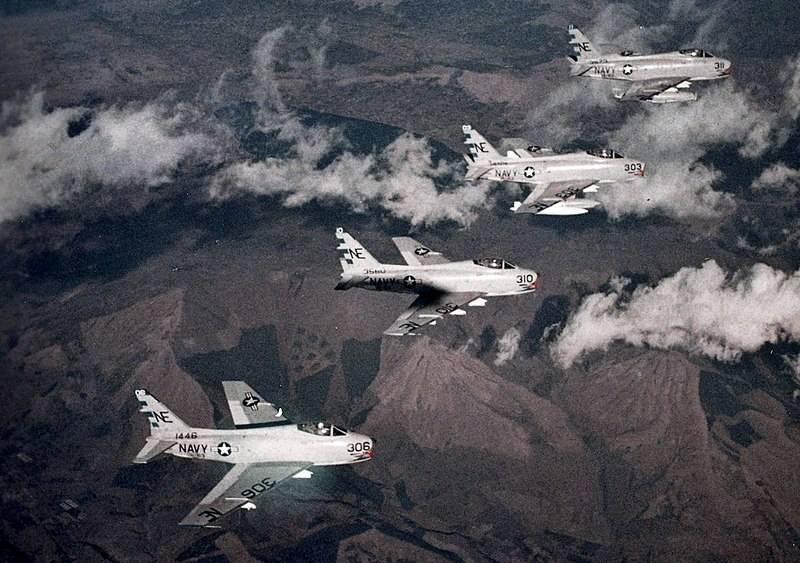
Simultaneously with the FJ3, the Navy and the ILC received the FJ4. This modification had a thinner wing profile and increased fuel capacity. The maximum take-off weight increased to 10750 kg, and the range with a PTB and two Sidewinder missiles reached 3200 km. Armament remains the same as in the early models of Fury, and the maximum speed at an altitude reached 1090 km / h. Just like the previous models of the deck "Saber", FJ4 began service as an interceptor fighter, but was later focused on solving shock tasks. In total, the fleet put 374 aircraft FJ4. Their operation in the Marine Corps continued until the end of the 60s.
To counter the Soviet torpedo bombers, Tu-14 and IL-28, which arrived in significant numbers in the regiments of the USSR Navy, the Americans needed more high-speed deck fighters. In connection with this, F50F Cougar from Grumman became the main deck interceptor in the second half of 9's. The Koguar was created on the basis of the F9F Panther jet-based fighter jet. The main difference from the "Panther" was wing swept form. The fleet command classified the Koguar as a new Panther model and therefore the aircraft had the same alphanumeric index.
A carrier-based fighter with a maximum take-off weight of 9520 kg was accelerated by a Pratt & Whitney J48-P-8A turbojet engine with a thrust of 38 kN to 1135 km / h. Practical flight range - 1500 km. To replenish the supply of fuel in the air, the aircraft had a refueling probe. Although the maximum flight speed of the Coguar was not much higher than that of the Fury, the upgraded deck-based Coguars had a long flight range, equipped with an APG-30A radar, an Aero 5D fire control system and air combat missiles. The built-in armament included four 20mm cannons.
The first Koguar VF-24 squadron was deployed on the USS Yorktown aircraft carrier (CV -10) in August 1953, but did not participate in the Korean operations. In 1958, the deck fighter pilots were transferred to more modern machines, but the Koguars continued to be used in reconnaissance and training squadrons. The double training version of the F9F-8T in the initial period of the war in Vietnam was used by the USMC as a reconnaissance and guidance aircraft. A total of about 1900 single and double Koguars were built, the last two-seater aircraft was written off in 1974 year.
It was assumed that the fighter F9F Cougar in the American carrier-based fighter squadrons will be replaced by a supersonic F11F Tiger. This aircraft was designed by experts Grumman, taking into account the "rules of the areas." The fighter, which first took to the air in the 1954 year, had good flight data. The aircraft with a maximum take-off weight of 10660 kg was equipped with a Wright J65-W-18 engine with a fork in the afterburner 47,6 kN and could accelerate in horizontal flight to 1210 km / h. The combat range with two AIM-9 Sidewinder URs and two outboard fuel tanks was 480 km. There was no radar on the "Tigre", targeting to the target was to be carried out by the commands of the shipborne radar or deck aircraft of the AWACS. The armament of serial fighters consisted of four 20-mm cannons, arranged in pairs under the air intakes, and four AIM-9 Sidewinder missiles with an infrared homing head.
The arrival of the Tigers in the squadron began in 1956 year. From the very beginning, the fighter proved itself to be positive and was popular with the flight and technical personnel. Pilots appreciated his excellent maneuverability and good handling at low speeds, which was especially important when landing on the deck of an aircraft carrier. The Tiger technicians have earned a reputation as a simple, easy-to-maintain and almost trouble-free aircraft.
However, with all its merits, F11F did not satisfy the admirals as a deck interceptor. The Tiger, because of its maneuvering characteristics, was almost ideally suited to the role of a fighter winning air superiority, but at the end of the 50s, information appeared on the creation of a long-range missile-carrying bomber Tu-16 in the USSR. The US Navy needed a fighter equipped with a radar, with long range and speed of flight. Serial production of "Tigers" ceased in the 1959 year, all in the deck squadron received about 180 F11F. Already in 1961, the aircraft was taken out of the first-line units, and in 1969, they finally dismissed.
Along with the relatively light "Fury", "Koguar" and "Tiger", American admirals considered it advisable to have a heavy deck interceptor, equipped with a powerful radar and capable of autonomous act at a considerable distance from the aircraft carrier. The company McDonnell embarked on the creation of such an aircraft in 1949, and in 1951 the first flight of the prototype took place. The plane seemed very promising, and the fleet placed an order for 528 deck interceptors. However, the tests were very hard, because of the unreliable performance of the Westinghouse XJ40 engine and the control system failures during test flights, the 12 experimental aircraft were broken, after which the order was reduced to 250 machines.
The first serial modification, which entered service in March 1956, received the designation F3H-1N Demon. The all-weather deck Demon was equipped with a Westinghouse J40-WE-22 turbojet engine with a fork in the afterburner 48 kN. The cars of the first modification, because of too whimsical engines, were not popular, and they were built by all 58 copies. F3H-2N, built in the number of 239 units, has become more massive. On this model was installed a more powerful engine Allison J71 - A2, issued in the afterburner mode 63,4 kN. But simultaneously with the increase in power, fuel consumption increased, and in order to maintain the previous flight range, the volume of fuel tanks had to be increased, which in turn led to an increase in the maximum take-off mass. The pilots did not like to take off with tanks filled with traffic jams, and with a maximum combat load. The "Demon" heavy duty was low and the slightest "sneeze" of a single engine taking off could lead to a catastrophe.
The F3H-1N Demon interceptor and the FJ3 Fury carrier-based bomber Fury make a joint flight in the 1958 year. Significant difference in the size of the aircraft
The Demon was the heaviest American carrier-based fighter of the mid-50. The maximum take-off weight of the F3H-2N modification was 15 380 kg, that is, almost two times more than that of Fury. The single interceptor F3H-2N at high altitude accelerated to 1152 km / h and had a combat radius of 920 km.
The plane carried a very advanced for its time radar AN / APG-51В / С with a detection range of up to 40 km. Prior to this, the early AN / APG-51А radar model was run-in on the F2H-4 Banshee deck interceptor. Due to the presence on board of this station "Demon" modification F3H-2М became the first naval fighter capable of using the AIM-7 Sparrow UR with a semi-active radar homing head. On the four external nodes, the AIM-9 Sidewinder and 70-mm NAR Mk 4 FFAR blocks could also be suspended. Built-in weapons included four 20-mm guns, placed under the cabin in a kind of chin. After the introduction of long-range missiles into the armament to reduce the mass of the aircraft, two guns were dismantled. After the "Demons" were able to carry long-range missiles, the order for them increased. In total, the US Navy received 519 F3H interceptors of all modifications.
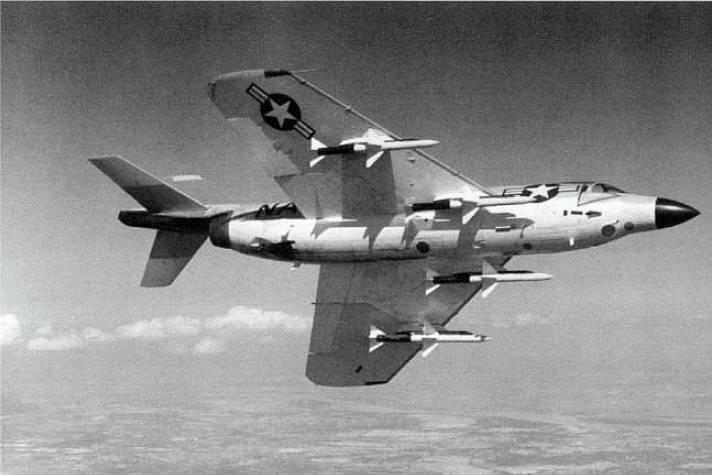
In the guise of "The Demon" features of the famous F-4 Phantom II, which appeared as a result of the development of the Super Demon project, look through. Although the Demon in the middle of 50 played a major role in providing air defense of aircraft carrier connections, like its other peers, he quickly left the stage at the beginning of 60's. After adopting the Crusader and Phantom supersonic, they completely supplanted all the Demons by 1964.
F50D Skyray (Douglas sky heaven) from the Douglas company considered the role of the patrol deck interceptor in the second half of the 4's in the US Navy and KMP, this aircraft was a kind of insurance in case the Demon interceptor could not be brought to normal condition. The F4D fighter conformed to its name and was built according to the “flying wing” scheme. In the serial modification of the aircraft was equipped with turbojet engines Pratt Whitney J57-P-2 with a brace on the afterburner 64,5 kN. The deck interceptor with a maximum take-off weight of 10200 kg had a combat radius of just over 350 km and could reach speeds up to 1200 km / h at high altitude. When flying without afterburner, at a speed of 780 km / h, the combat radius could exceed 500 km. The armament was the same as on other deck fighters - four 20-mm cannons and an AIM-9 UR. However, at the time of development, the main weapons F4D was considered the 70-mm unmanaged air-to-air missiles Mk 4 FFAR, better known as the Mighty Mouse (the Mighty Mouse is the hero of comics and animated films). American strategists, impressed by the German experience in the use of unguided missiles, believed that a massive NAR volley would destroy the bomber without entering the zone of action of its defensive artillery installations. The devastating effect of hitting a single 70-mm rocket was comparable to that of an 75-mm fragmentation projectile. At a range of 700 m about a third of the salvo in 42 NAR hit the target size 3x15 m. In total, on board the interceptor could be up to 76 unguided rockets in four blocks. The APQ-50A airborne radar could detect bombers at a distance of up to 25 km. The avionics included a fire control system Aero 13F, coupled on the radio relay line with the ship's command and control system.
The sky-batch serial flew off in July 1954, and in the spring of 1956, the first combat squadron of the VF-74 relocated to the aircraft carrier USS Franklin D. Roosevelt (CV-42). For its time, the Heavenly Skate was a good interceptor and had a good rate of climb (90 m / s), but in the closest air combat it was hopelessly inferior to other American fighter aircraft. The serial production of the F4D Skyray was carried out until the 1958 of the year, the entire fleet and the Marine Corps received the 422 aircraft. The “heavenly slope” was not much longer than the “Tiger” was in active service. In 1964, all deck interceptors were written off ashore, and they provided air defense to naval bases for a few more years.
In the mid-to-late 50s, five different types of deck fighters were in service in the American Navy aviation at the same time, among which there were also very different modifications from each other. This, of course, complicated the logistics of the supply of spare parts and operation, and required separate training for pilots and technical staff. After analyzing the state of affairs, the command of the naval forces came to the conclusion that it was necessary to reduce the number of types of fighters adopted by the new generation. In part, this was achieved, but at the same time, in the 60-70-ies, the different types of American carrier-based strike aircraft increased.
At the start of the 50, American military analysts predicted the early appearance of anti-ship cruise missiles and supersonic bombers in the USSR. Existing carrier-based fighters, as expected, could not adequately fend off these threats. For effective interception of such air targets, a supersonic fighter with a flight speed of more than 1,2M and a combat radius of at least 500 km was required. In order to independently search for targets on a prospective deck fighter, there had to be a powerful radar station, and self-guided air combat missiles were part of the armament.
At the beginning of 1953, the US Navy announced a competition for the creation of a deck-mounted interceptor fighter, which, in addition to fighting high-altitude speed targets, was supposed to surpass the Soviet MiG-15 in a maneuverable air battle. The four competitors admitted to the finals, along with Vought's V-383 model, included Grumman's XF11F-2, a twin-engine version of the F3H-G from McDonnell and North American with a deck version of the F-100. In May, 1953 was announced the winner of the V-383 after reviewing the projects. The project was given the designation F8U-1, and Vought was obliged to provide a wooden model for blowing in the wind tunnel as soon as possible. According to the results of blowing models in the wind tunnel and after the positive conclusion of the mockup commission, in June 1953 of the year the fleet ordered three prototypes. Already 25 March 1955, the head XF8U-1, having taken off from Edwards Air Base, exceeded the speed of sound in the first flight. Without waiting for the end of the test, the admirals placed an order for a serial batch of fighters. As a result, the first serial F8U-1 took off in September 1955, simultaneously with the second prototype XF8U-1. The aircraft, which received the brand designation F8U-1 Crusader (Russian Crusader), in April 1956, was tested on the aircraft carrier USS Forrestal (CV-59). 21 August 1956 of the Year “Crusader” over the China Lake range in California accelerated to speed 1 634 km / h. In December, new fighters began to enter into service armament squadrons. By the end of the 1957 of the year, the Crusaders were in service with the 11 deck squadrons of the Navy and ILC.
When creating the aircraft was implemented a number of technical innovations. Highly positioned wing sweep 42 ° equipped with a system for changing the angle of installation. During takeoff and landing, the wing mounting angle increased by 7 °, which increased the angle of attack, but the fuselage remained in a horizontal position. At the same time, the ailerons and slats, located along the entire span of the leading edge of the wing, were automatically deflected to 25 °. Between the ailerons and the fuselage were flaps deviated by 30 °. After takeoff, the wing descended and all deflected surfaces assumed a flight position.
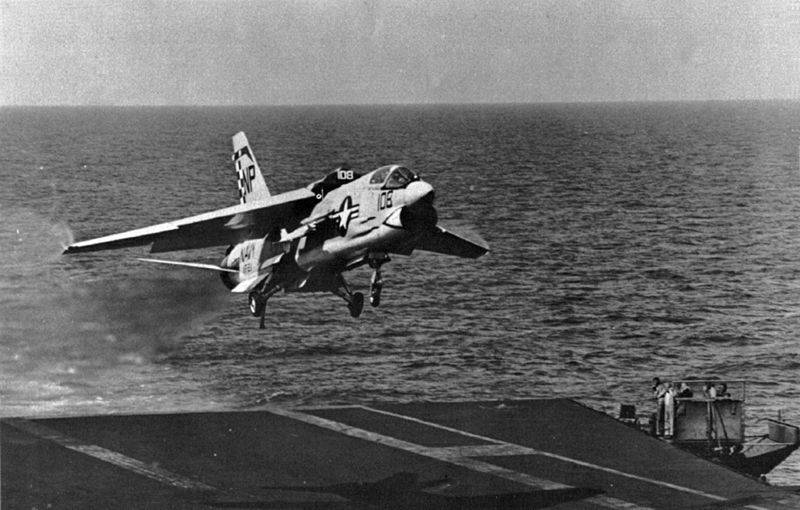
Due to the variable angle of installation and wing mechanization, it was possible to facilitate the landing and reduce the load on the chassis. Landing was possible with the wing down, and this happened repeatedly. However, this mode was considered dangerous due to the worst controllability. The high wing considerably simplified the maintenance of the aircraft and the work of gunsmiths. The end of the wing folded up to reduce the footprint on the deck and in the inner hangar of the aircraft carrier. In accordance with the "rule of the areas" the fuselage was narrowed in the area of conjugation with the wing. In the forward part of the fuselage was an oval-shaped frontal air intake, above which was placed the radio-transparent radome fairing APG-30. When creating the aircraft, titanium alloys were widely used, which made it possible to increase the weight perfection of the design. Along with advanced technical solutions, the promising deck fighter inherited from its predecessors a battery of 20-mm Colt Mk.12 guns with 144 ammunition for a projectile on the barrel and 70-mm NAR Mk 4 FFAR.
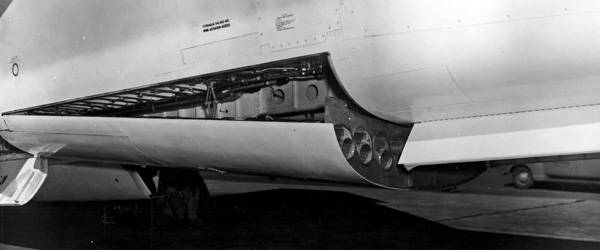
In the ventral container fit 32 70-mm rocket. Although the F8U-1 was supposed to be the fastest naval fighter, it was foreseen at the design stage that it would retain the possibility of conducting close, maneuverable air combat. "Crusader" was the last American carrier-based fighter, on which the gun was originally provided as the main weapon. Due to the fact that the wing has changed the angle of inclination during takeoff and landing, additional armament suspension units had to be placed on the fuselage.
Shortly after they entered service, the aircraft began to be equipped with an in-flight refueling system. This made it possible to significantly increase the combat radius and ferry range. For the fuel receiver, they found a place under the convex fairing on the left side behind the canopy. The aircraft of the first series were equipped with a Pratt Whitney J57-P-12A or J57-P-4A engine with a brace on the afterburner 72,06 kN.
In September 1958, the second F8U-1E serial version appeared. The fighter converted from F8U-1 was notable for the new AN / APS-67 radar with a smaller antenna diameter. On this model, the ventral container with the NAR was sewn up tightly. Thanks to a more advanced radar, the F8U-1Е was able to operate at night and in bad weather. But for the withdrawal of the aircraft to the target, the commands of the operator of the shipborne surveillance radar or DRLO aircraft were required. In February, the 1960 on tests passed the fighter F8U-2N with advanced on-board avionics, facilitating piloting at night. The main innovation was the automatic landing system, which allows you to hold the landing speed with an accuracy of ± 7,5 km / h, regardless of the speed and direction of the wind, using an onboard computer. Thanks to the introduction of this system, it was possible to significantly reduce the accident rate. The fighters installed new engines J57-P-20 with a nominal thrust 47,6 kN (at the forcing section 80,1 kN). Due to this, the maximum flight speed at an altitude of 10 675 m could reach 1 975 km / h. On the ground, the Kruseider accelerated to 1226 km / h. At the place of the useless compartment with NAR, an additional fuel tank was installed, which made it possible to bring the fuel to the 5 102 l. Maximum take-off weight reached 15540 kg. Normal, with two AIM-9 SD - 13 645 kg. Combat radius with two air combat missiles - 660 km.
Already in June, the 1961 of the year began testing the following F8U-2NE modification with the AN / APQ-94 radar, which the Tu-16 bomber could detect at a distance of up to 45 km. To accommodate a larger radar antenna, we had to slightly increase the size of the radiotransparent fairing. An infrared sensor appeared over the radome of the radar.
F-8E (F8U-2NE) from the US KMP Aviation at Danang Air Base in April 1966. IR sensor is well visible above radome radar
After capturing the target of the IG GOS of the AIM-9 Sidewinder rocket, the pilot continuously monitored the distance to the target of the attack using radar. Information about the distance was displayed using light indicators and after reaching the allowed launch distance was duplicated by an audible signal. In addition, in the “hump” above the center section, equipment for radio command guidance of the air-surface AGM-12 Bullpup was placed. For strikes against ground targets, blocks with 70-127-mm NAR and bombs weighing 113-907 kg could be used. Typically, the typical impact configuration was four 454-kg bombs and eight 127-mm NAR Zuni on fuselage nodes.
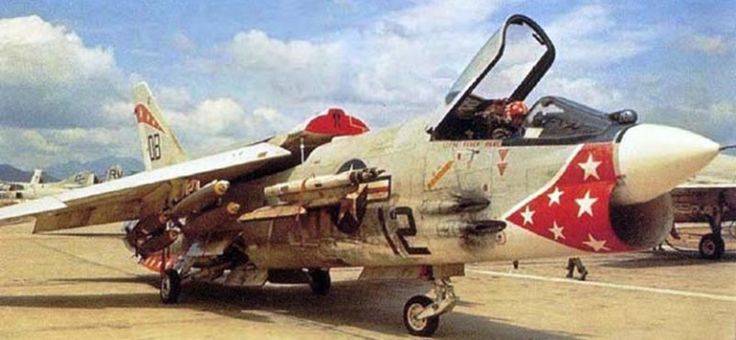
The “all-weather” and “all-daily” F8U-2NE serial “Crusaders” began to be mastered by combatant pilots at the end of the 1961 year. The following year, changed the system of marine aircraft designation of the type adopted by the Air Force, in which F8U-1 has received the designation F-8A, F8U-1E - F-8B, F8U-2 - F-8C, F8U-2N - F-8D, F8U-2NE - F-8E. Production of the F-8E continued until the 1965 year. For ten years, 1261 aircraft were built.
At the beginning of the life of the "Crusader" was very emergency vehicle. Landing on it has always been a difficult task, compared to the fighters of the previous generation F-8 fought much more often. On the 100 000 flying hours, the F-8 had 50 flying accidents, while the A-4 Skyhawk had 36. However, after the introduction of the automatic speed control system at landing and the accumulation of experience by the flight crew, the accident rate was reduced. Nevertheless, the "Kruseyder" had a reputation for strict management of the machine. At the same time, the F-8 kept up fairly well even with a fairly maneuverable FJ3 Fury fighter, which was largely due to the relatively low stall speed, which was just 249 km / h. To train pilots, a certain amount of F-8A being removed from service was converted into twin-training TF-8A training aircraft with dual control.
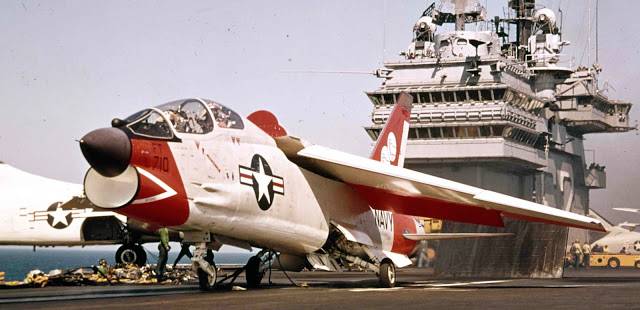
With the training aircraft dismantled two guns. The maximum speed was limited to 1590 km / h. Pilot-instructor sat in the rear cockpit with excess over the cadet.
With "Kruseyderom" sometimes there were quite unusual episodes. In August, the 1960 of the year, due to the negligence of the pilot and flight leader, the Kruseyder, took off from the airfield runway near Naples with folded wing consoles. At an altitude of 1,5 km, after transferring the engine to the nominal mode of operation, the pilot discovered that the plane was not keeping well in the air and responded sluggishly to commands from the controls. However, instead of ejecting, the pilot poured the fuel and, after 20 minutes, the fighter safely landed. According to US data, there were eight such cases in the biography of F-8.
Another story happened to a young pilot at the end of the 60-x when practicing landing at Lekhurst airbase. Twice he failed to catch a hook on the landing cables, during the third approach he panicked, lost control of the plane and ejected. After that, the unmanned F-8H went down and made a “landing” on its own, hooking the rope with a hook. In this case, the plane received minor damage and was quickly repaired.
Speaking about the deck of the Crusader, it is impossible not to mention the unarmed reconnaissance modification. Deliveries of the F8U-1P reconnaissance fleet based on F8U-1 began in the 1957 year. Cameras were placed in place of the dismantled 20-mm guns. According to some reports, the scouts could carry AIM-9 missiles for self-defense, but it was not known whether they used this opportunity during actual combat missions. The pledge of the invulnerability of reconnaissance aircraft should have been high speed and maneuverability. After the change of the aircraft designation system in the 1962 year, they became known as RF-8A. Subsequently, the upgraded version with the new reconnaissance, communications and navigation equipment received the designation RF-8G.
The RF-8A scouts played a prominent role in the Caribbean Crisis. From October 23 1962, they almost daily carried out reconnaissance missions over the "Island of Freedom" as part of Operation Blue Moon (Rus. Blue Moon). Aircraft from the naval reconnaissance squadrons VFP-62 and VFP-63 and the squadron VMCJ-2 of the Marine Corps aviation made risky low-altitude flights. At the same time they were fired by the Cuban anti-aircraft artillery. Although reconnaissance "Kruseydery" repeatedly returned with holes, losses were avoided. The scouts took off from Key West Florida Air Base and returned to Jacksonville. The flights continued for a month and a half, with about 160000 shots taken. At the initial stage of the Vietnam War, reconnaissance "Kruseydery" played an important role in the planning of combat missions of the American carrier-based strike aircraft.
Although by the middle of the 60's, the Kruseyder was sufficiently advanced and well mastered by combat squadrons, he fell victim to the desire of the US Navy command to have deck wings, albeit more expensive and heavy, but universal fighters. "Kruseydera" inferior F-4 Phantom II mass of the bomb load in the shock configuration. In addition, due to the different location of the air intakes, the heavier twin-engine "Phantom" was able to accommodate a more powerful and, therefore, long-range radar, which in turn ensured the use of medium-range missiles with a radar homing, regardless of visual visibility conditions. The presence of the navigator-operator in the crew of the two-seater Phantom facilitated the task of guiding missiles requiring continuous radar target illumination, and since this operation was carried out in semi-automatic mode, it was difficult for the pilot to simultaneously fly the fighter and direct the missile at a single-seater Krusader. .
In the 60s, both in the United States and the USSR, the prevailing opinion was that air combat would be reduced to rocket duels in the future. The winner in equal conditions will be the one who will have more powerful airborne radar and long-range missiles. On the basis of this, an erroneous conclusion was made that fighters armed with guns are an anachronism. The experience of fighting in Southeast Asia, where American fighters clashed with Soviet MiGs, demonstrated the fallacy of such views, and Krusader proved its relevance. Pilots "Phantoms" early modifications indicated the absence of guns in the arsenal of this multifunctional fighter, as one of the most serious shortcomings. In addition, the lighter and maneuverable Kruseyder was easier to hold onto the tail of the MiG-17 or MiG-21, performing a turn or combat reversal than the heavier Phantom, but more on this in the second part of the review.
To be continued ...
Based on:
Global Security.org. US Military Aircraft. Douglas F4D Skyray
https://wiki.baloogancampaign.com/index.php/DataSensor?ID=1000278
http://www.aviation-gb7.ru/F-8.htm
http://airwar.ru/enc/fighter/f3h.html
http://www.vectorsite.net/avcrus_1.html
https://flyawaysimulation.com/downloads/files/23248/fsx-us-marines-vought-f-8e-crusader-of-vmf-235/
http://www.designation-systems.net/usmilav/jetds/an-apr2aps.html
https://www.globalsecurity.org/military/systems/aircraft/f-8.htm
https://web.archive.org/web/20080808141828/http://www.vectorsite.net/avcrus_2.html#m1
http://tailhooktopics.blogspot.ru/2013/03/vought-f8u-1t-twosader.html
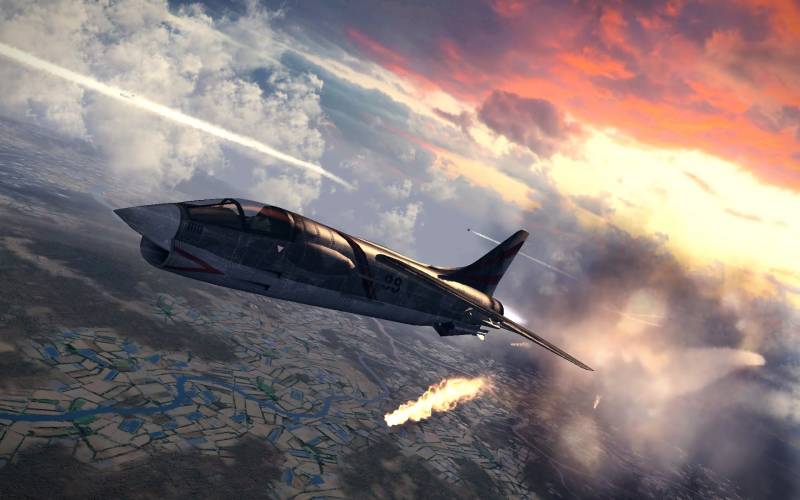
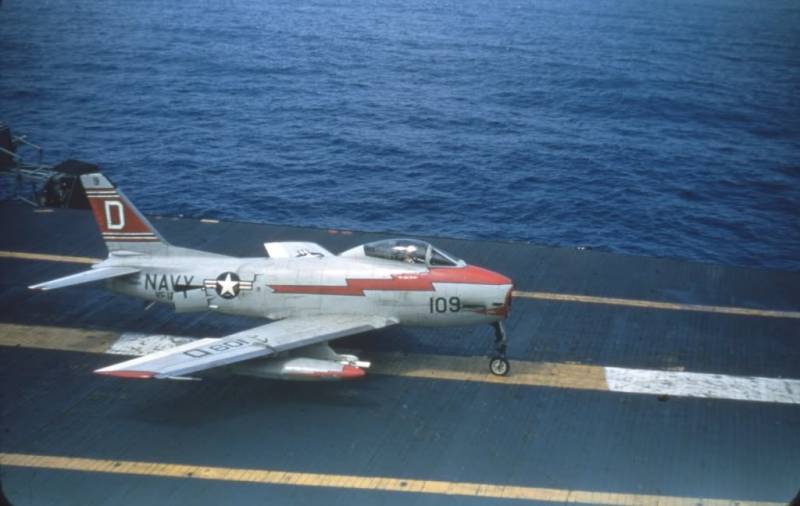
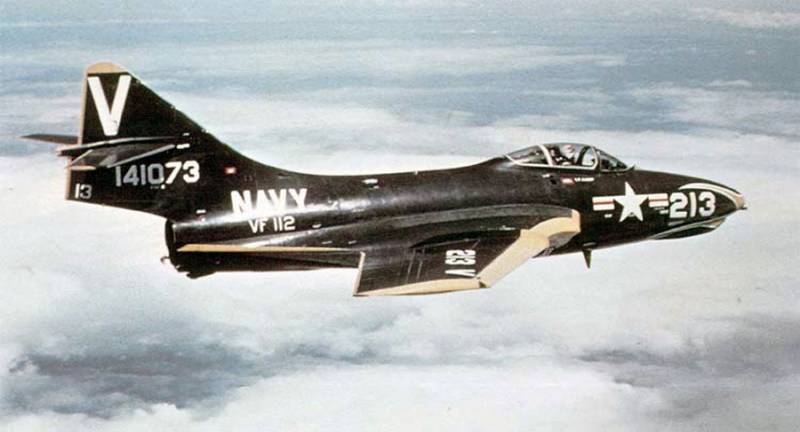
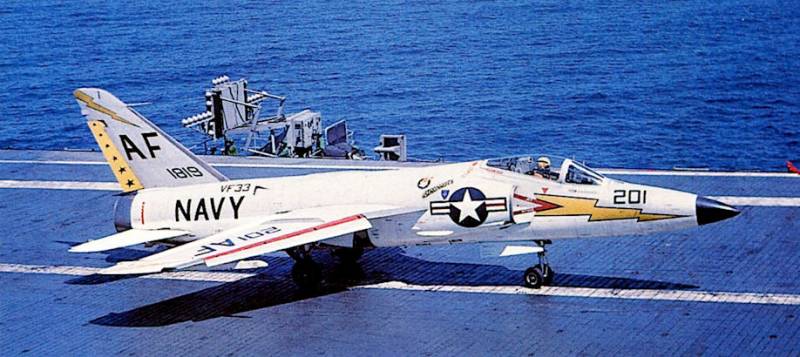
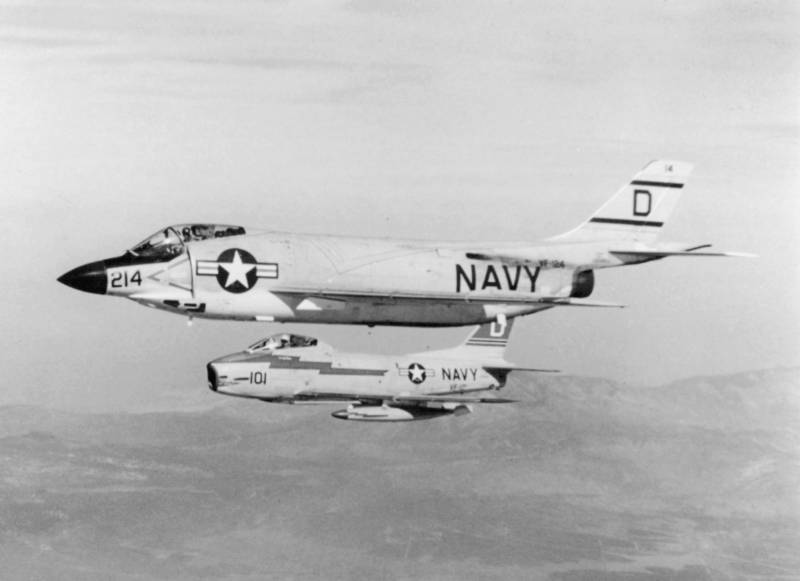
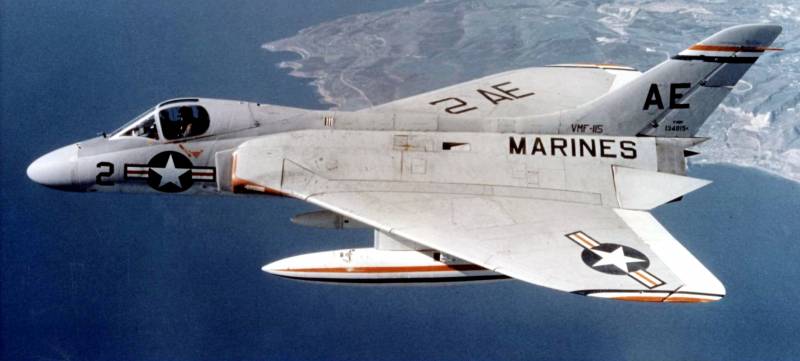
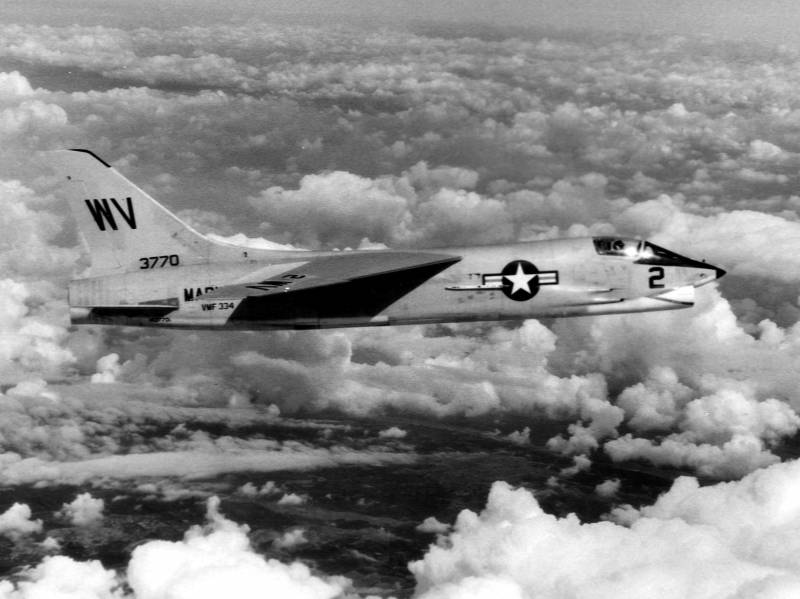
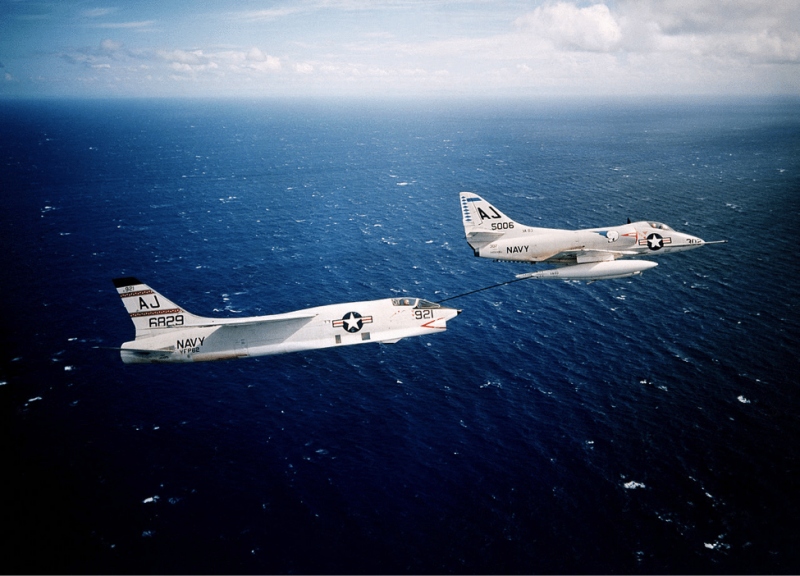
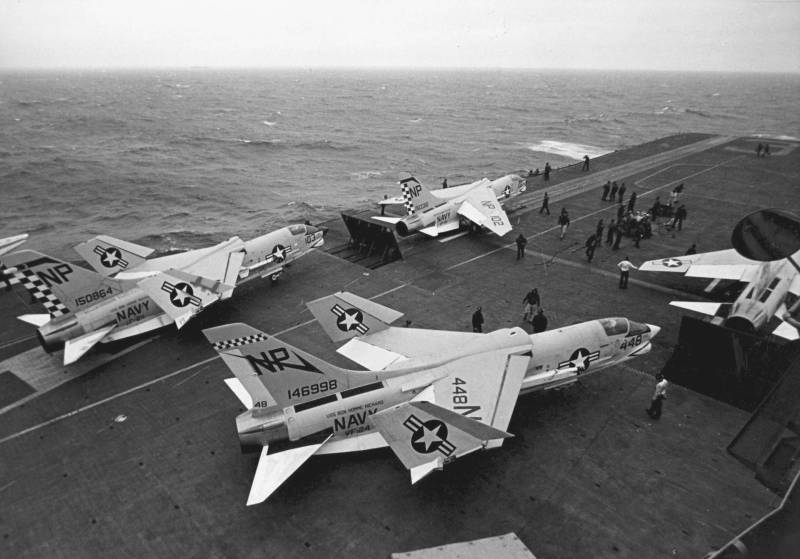
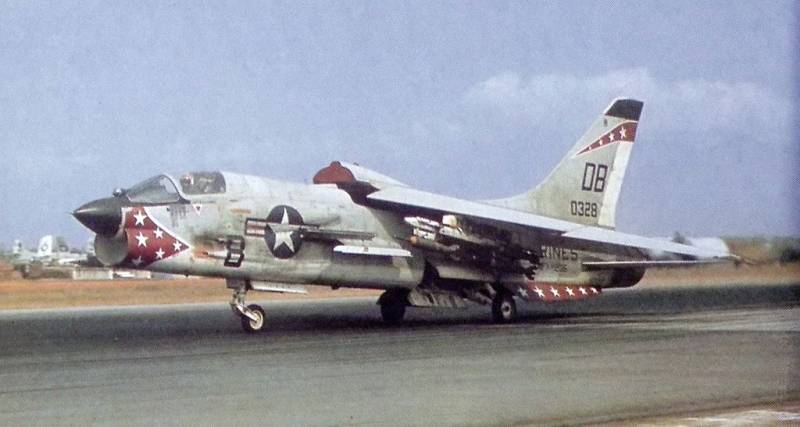
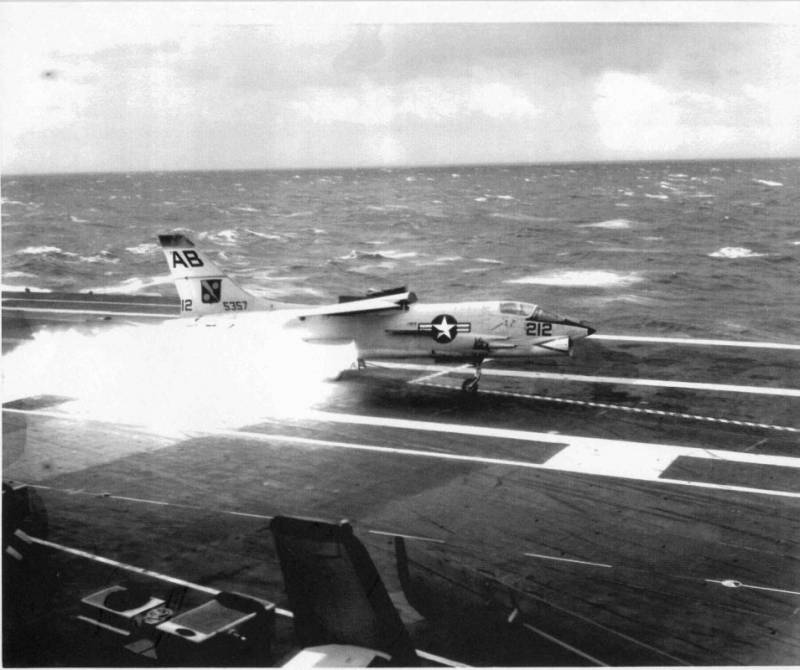
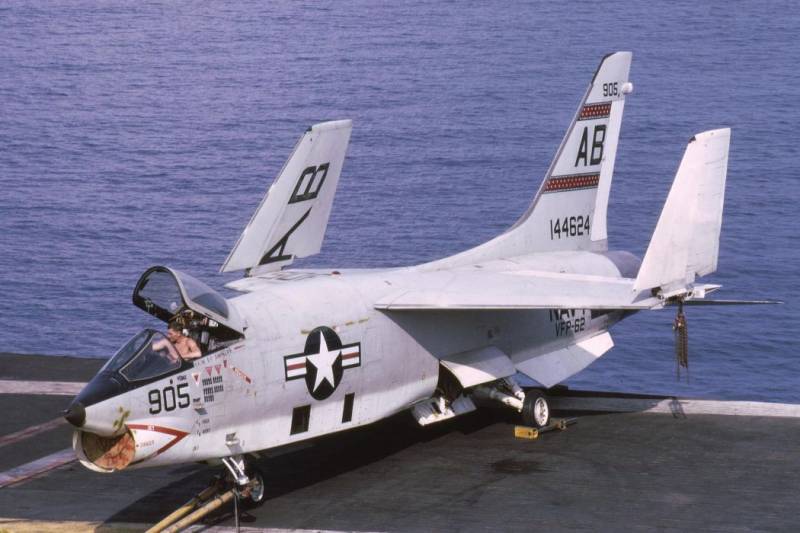
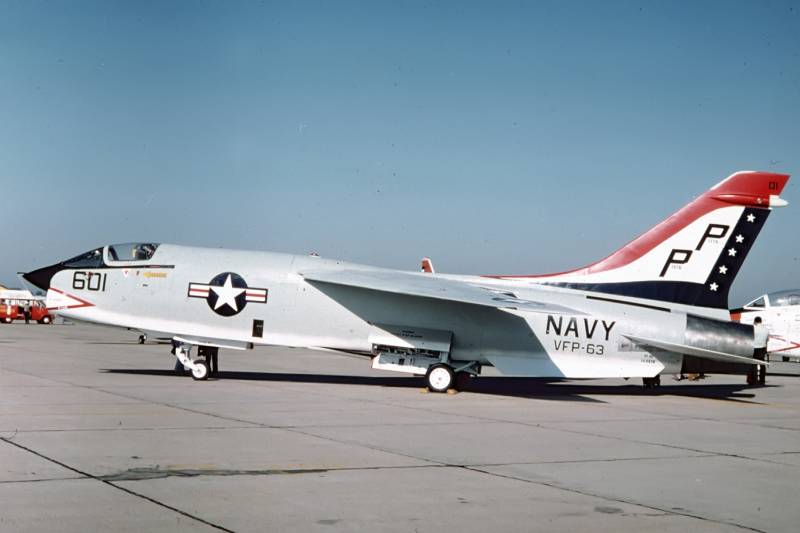
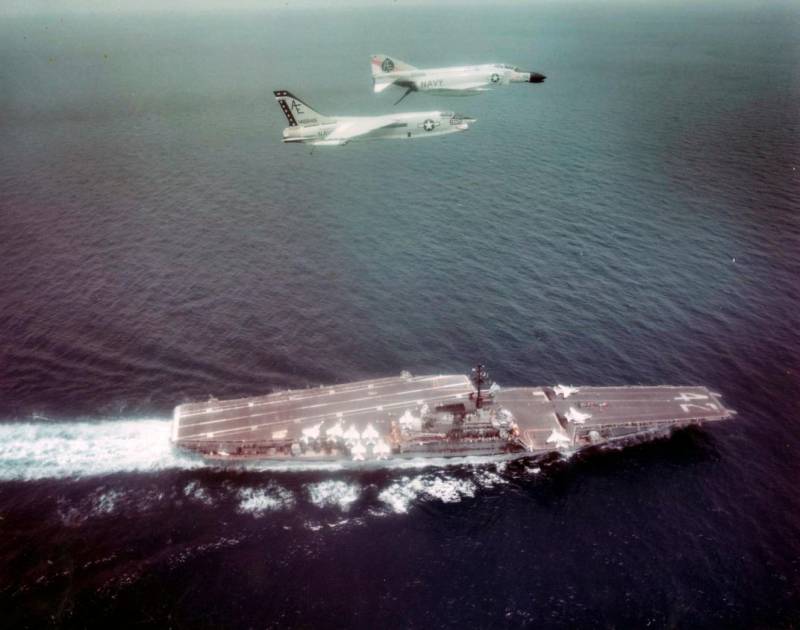
Information